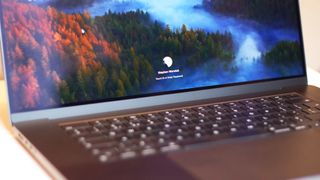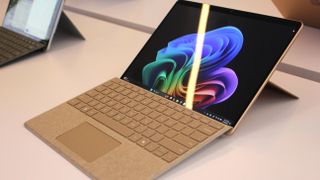'I'm a Mac' guy is now a Copilot+ PC guy in this confusing and hypocritical commercial
Justin Long, who famously featured in Apple ads for years, now wants a Snapdragon-powered PC.

What you need to know
- Qualcomm concluded its keynote at Computex with an advertisement featuring Justin Long.
- Long famously featured in ads for Apple as the "I'm a Mac" guy a couple of decades ago.
- The ad highlights several issues of using a MacBook, though confusingly many of those issues also occur on Windows PCs.
- Long has been in anti-Apple ads in the past, including Intel commercials made shortly after Apple spurned the chipmaker in favor of Apple-made processors.
Qualcomm is hyped about its new Snapdragon X Elite and Snapdragon Plus processors. Those chips power Copilot+ PCs that start shipping later this month, including the Surface Pro 11, Surface Laptop 7, and PCs from Acer, ASUS, Dell, HP, Lenovo, and Samsung. Qualcomm just wrapped up its Computex 2024 Keynote titled "The PC Reborn." The keynote has more than an hour of insight and facts outlining the future of Snapdragon X-powered PCs. It also features an ad that is rather strange.
The keynote concludes with a commercial featuring Justin Long, who famously starred in Apple's "I'm a Mac" advertisements 20 years ago. Long, as you would expect during a Qualcomm keynote, felt inspired to switch over to a PC with a Snapdragon chip inside.
A company hiring a famous actor to promote a product is not surprising. Using an actor who previously worked for a rival company is also common in the industry. The Verizon "can you hear me now" person later worked for Sprint. But rather than highlight things that make Snapdragon-powered PCs a better option than a MacBook, such as price, connectivity options, and form factor flexibility, Qualcomm decided to highlight a bunch of issues that appear on both Macs and PCs.
Will this age like milk?
Jump to the 1:17:06 mark of the video above to see the Justin Long commercial.
While it's true that Apple's M-series has started seeing diminishing returns in each generational update, I wouldn't bet against Apple. The tech giant has successfully made the transition from Intel to Arm, getting developers on board and setting the standard for Arm-based computing. I'd venture to guess most people with Arm chips in a MacBook don't even consider what type of processor their system runs. They just know it works.
In contrast, Windows is on the beginning of a new journey in Arm computing. Windows on Arm has been around for years, but it looks set to hit its stride in 2024. Major manufacturers are finally on board. As highlighted by our Editor-in-Chief Daniel Rubino, Dell is "all" in on Snapdragon X and has five devices on the way powered by the chips. Dell had only released one Arm PC in the last seven years, so things have clearly turned a corner. Acer, ASUS, HP, Lenovo, Microsoft, and Samsung are all on board as well when it comes to Windows on Arm.
There are finally chips that look promising in the Snapdragon X Elite and Snapdragon X Plus. Those processors have benchmarks that stack up well against Apple's chips, which is impressive given they're first-gen products going against processors on at least their third iteration.
Get the Windows Central Newsletter
All the latest news, reviews, and guides for Windows and Xbox diehards.
Let's take a closer look at the specific things that "inspired" actor Justin Long to look for a Snapdragon X-powered PC and see if they're issues exclusive to macOS and Apple hardware.

The ad starts off with Long's character seeing a bunch of notifications, including breaking news, an email, and a prompt that says "App is not optimized for your Mac." He then gets inundated with a low battery warning, another email, a schedule reminder, and a social media notification. Those annoyances drive Long's character to search for Snapdragon powered PC.
None of the issues presented in the ad are exclusive to macOS. People can get spammed by notifications on a Mac or PC. Both operating systems have something akin to "Do Not Disturb" mode, so I'm not sure what the ad is getting at here. Long's character got a couple of emails, but Outlook's spam filters are terrible, so jumping into the Microsoft ecosystem wouldn't help there. Of course, you can use whatever email client you want on macOS or Windows regardless of the processor your system has.
Qualcomm's inclusion of a low battery life warning is also strange. When our colleagues at Tom's Guide reviewed the M3 MacBook Pro, the laptop delivered nearly better battery life than any Windows PC except for the brief-case sized Panasonic Toughbook 40. It seems unlikely that the battery life of M-Series MacBooks will be considered a weak point when compared to PCs with a Snapdragon chip inside, even if Qualcomm has managed to close the gap.

The prompt about an app not being optimized for Mac is especially confusing. While big-name app makers are optimizing their apps for Windows on Arm, there are plenty of apps that will have to run through emulation. Emulated apps should perform fine on PCs running Windows 11 on Arm, but many will run through emulation. That's a similar situation to what's seen on the Apple side of things.
The only criticism that holds a bit of weight is the prompt about running out of disk space. Many complain that base models of the MacBook Air only have 256GB of storage and that you can't upgrade your SSD after buying the computer. Of course, The Surface Pro 11 has 256GB of storage on its base model, so maybe limited disk space isn't exclusive to MacBooks.
Apple has survived a targeted ad featuring Long before. The actor was hired by Intel a few years ago shortly after Apple spurned Intel in favor of Apple-made chips. I suspect Apple will survive this strange ad from Qualcomm as well.

Sean Endicott is a tech journalist at Windows Central, specializing in Windows, Microsoft software, AI, and PCs. He's covered major launches, from Windows 10 and 11 to the rise of AI tools like ChatGPT. Sean's journey began with the Lumia 740, leading to strong ties with app developers. Outside writing, he coaches American football, utilizing Microsoft services to manage his team. He studied broadcast journalism at Nottingham Trent University and is active on X @SeanEndicott_ and Threads @sean_endicott_.
